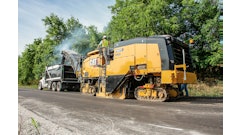
Two studies sponsored by the Pavement Coatings Technology Council (PCTC) have determined that refined tar-based sealants are not the main source of PAH’s in the environment – a claim based on flawed studies conducted in 2005 in Austin, TX.
Those Austin studies have resulted in regulatory challenges and even sealer bans in some locations that are based on the theory that refined tar-based sealants are the main source of a class of chemicals called polycyclic aromatic hydrocarbons (PAHs) in the environment. The challenges and bans are based on a study in Austin, Texas which showed that refined tar-based sealant contains PAHs and that soil or sediment samples taken next to a sealed parking lot sometimes contain high levels of PAHs. That study was the first to propose a link between the PAHs in refined tar-based sealant and PAHs in rivers, streams and lakes. But something important was not considered: data from samples of stream sediments in Austin, TX, that had been collected and reported just a few years before the study was conducted.
No one is surprised that refined tar-based sealant contains PAHs. PAHs are everywhere in the environment and are formed by burning organic matter. PAHs are found in used motor oil, grilled meats and vegetables, exhaust from internal combustion engines and emissions from fossil fuel power plants, forest fires and volcanoes as well as products made from coal and petroleum.
Tar-based sealants contain PAHs, yes, but when all the data available in Austin were considered, it looked very much as though refined tar-based sealant was, in fact, not a major source in sediments downstream of the immediate area of a sealcoated lot. Thus it was that the Pavement Coatings Technology Council (PCTC) began sponsoring research into possible impacts of refined tar-based sealant in the environment, focusing on the whether refined tar-based sealant is a major contributor of PAHs to the environment.
The city of Austin banned the use of refined tar-based sealant within the city effective January 1, 2006. But a local environmental company had collected sediment samples from Austin’s streams before the ban, in October 2005, and again after the ban in April 2008. Total concentrations of PAHs in sediments before and after the ban did not change; if sealer was the principal source of PAHs in sediments then PAH concentrations should have declined once the ban was in place. Because this didn’t happen it’s clear that sealants are not the principal source of PAHs in sediments.
“Fingerprinting” Finds Sealants Not PAH Source
PAHs in the Austin samples were also evaluated using environmental forensics techniques. PAH fingerprinting of sediments collected before and after the ban also did not identify any marked changes. Results of this study of the ban’s impact were just published in a paper titled ‘Polycyclic Aromatic Hydrocarbons (PAHs) in Austin Sediments after a Ban on Pavement Sealers” in Environmental Forensics, the journal of the International Society of Environmental Forensics.
What is environmental forensics? It’s a combination of analytical and environmental chemistry used to evaluate allegations that specific types of pollution are caused by specific activities or materials. Forensic techniques have been used to unravel sources of many different types of environmental contaminants, using chemical “fingerprinting” methods that have been developed to help identify and sometimes distinguish between different sources.
PAH fingerprinting has been used in many situations where a complicated mixture of different PAH compounds is present. For example, PAH fingerprinting was used in court cases related to the Exxon Valdez oil spill to determine how much of the PAHs in sediments in Prince William Sound were from the spilled oil and how much from other sources, such as the naturally occurring coal seams in rocks in the area.
PCTC went to the “man who wrote the book” on PAH forensics, Paul Boehm, and asked him to apply forensic methods to the question of whether RTS are a significant source of PAHs in sediments.
In the September 2010 issue of Stormwater magazine, Boehm and his team published their first evaluation. In Figure 2 of their article (Boehm and others, 2010), refined tar-based sealant clearly appears to have a distinct PAH fingerprint that is not uniquely reflected in PAH analysis of a variety of environmental samples with the possible exception of sediments in the immediate vicinity of sealcoated lots. The article concludes:
“PAHs are ubiquitous and have multiple sources in urban environments. As a result, PAHs are common constituents in stormwater and in urban sediments. While the atmospheric deposition of combustion products is typically the most significant pathway that introduces PAHs to urban sediments, a number of other point and nonpoint sources also contribute… While pavement seal-coating can introduce PAHs into runoff and have measurable localized contributions, the available literature suggests that other sources, especially combustion sources, represent the vast majority of PAH inputs to urban sediments.”
Boehm and his team are conducting a more in-depth forensic analysis of PAHs in sediments, which will be one of the topics at the free seminar C-21, “Sealcoating: Regulatory Challenges and Industry Initiatives” at National Pavement Expo February 4 in Nashville. Preliminary results were presented at the annual meeting of the Society for Environmental Toxicology and Chemistry in November 2010, with the conclusion that PAHs in sediment samples collected throughout the country were more similar to PAHs typically found in atmospheric particles than in PAHs in samples associated with refined tar-based sealant. They concluded that sealants are not a primary source of PAHs in urban sediments.
Given the results of studies sponsored by PCTC, it’s reasonable to ask how it is that some scientists continue to claim that PAHs in sediments throughout the United States have their origin in application of refined tar-based sealant to parking lots and driveways. PCTC believes that by basing all later calculations on the flawed conclusions first presented in the incomplete 2005 study in Austin, those scientists have constructed a theory with the shakiest of foundation.
In the most recent publications, those scientists attribute volumes of PAHs to refined tar-based sealant that are supported by no facts or figures. Those imaginary volumes are then fed into a mass balance model (previously only used to model atmospheric effects) to come up with equally imaginary “percentages” of refined tar-based sealant -source PAHs in sediments. There’s an old saying about mathematical models: “Garbage in – garbage out.”




















